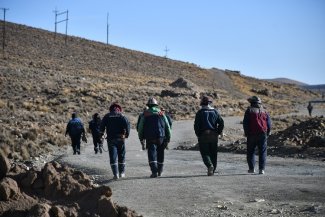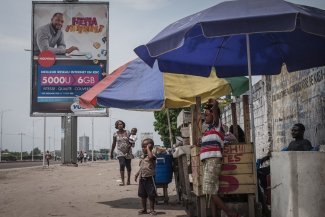In March 2017, locals stand in front of bags of maize in a community grain bank in Fiang-Ouzzang, a village in Cameroon’s Far North region.
Since 2013, Cameroon has been grappling with a humanitarian crisis provoked by repeated incursions by Islamic Boko Haram militants from neighbouring Nigeria. Numerous terrorist attacks have forced some 200,000 people in the semi-Saharan northern region of the country to flee their homes, while abandoning their farms and livestock to resettle elsewhere.
This forced internal migration – compounded by an influx of refugees from neighbouring countries in the Lake Chad Basin fleeing both Boko Haram and prolonged political tensions in the Central African Republic – has triggered a severe food crisis in the region, a situation akin to other parts of the Sahel (the area stretching from northern Senegal through to the Sudan) and east Africa.
The European Commission’s Humanitarian Aid and Civil Protection office estimates that some 42 million people in the Sahel are either moderately or severely food insecure, including 9.3 million people in need of emergency food assistance.
Meanwhile, some 20 million people – including millions of children, across Somalia, Ethiopia, South Sudan, and Kenya – are in urgent need of food and water as one of the biggest humanitarian crises in modern history continues to unfold in east Africa.
According to Bukar Tijani, the assistant director-general of the United Nation’s Food and Agricultural Organisation (FAO) and regional representative for Africa, unfavourable climatic conditions in the region – which is home to more than 50 million people and represents one of the poorest and most drought-prone regions in the world – are also a major cause for concern.
“Since 2015, sub-Saharan Africa has again experienced severe climate-induced disruptions because of the El Niño and La Niña weather phenomena. In terms of severity and extent, the ongoing El Niño and La Niña, with their related droughts and floods, are considered the worst since the turn of the century, and have affected the livelihoods of tens of millions of poor households,” he says.
Dr Richard Munang, regional climate change coordinator for the United Nations Environment Progamme (UNEP) in Nairobi, tells Equal Times that climate change threatens to reduce agriculture productivity in Africa by as much as 40 per cent with degraded ecosystems resulting in loss of water, pollinators and healthy soils, etc. “Lack of value addition means Africa losses up to US$4 billion worth of food annually on post harvest losses, and spends up to US$35 billion to import food to offset periodic shortages.”
Community efforts
But the people of northern Cameroon may have come up with a sustainable way to tackle food insecurity in the form of community grain banks. Grains such as maize, sorghum and wheat are staple foods for the people. Sandrine Kouba of the Network for the Fight Against Hunger (RELUFA), a local NGO fronting the resilience efforts, says that instead of selling their yields to merchants who hoard the produce to maximise profits later in the year, the crops are stored in village granaries. “When families run out of their own reserves, they can take half to one bag of grains on in-kind credit and pay back this loan from the next sorghum harvest later in the year,” she says.
Previously, locals would sell their crops immediately after harvest to earn money to attend to their family needs, despite this being the time when they would get the lowest prices for their grains. Traders would then take advantage of the low buying prices to stock up on supplies, which would later be sold at cut-throat prices once food became scarce.
Robert Konai, a member of a community grain bank in the village of Mounoum in Cameroon’s Far Northern region, says that when families ran out of their own supplies, they would be forced to sell off their livestock or borrow money to purchase vital grains. By this time, the prices for the grains would be soaring, while livestock prices would plummet, thereby sending locals into a downward spiral of poverty and food insecurity. “Traders used to play a fast one on us but the community grain bank is helping vulnerable people rather than serving the money men,” he tells Equal Times.
A young widow named Ajara Fatima sits behind her thatched house in the small locality of Parwai near to the Far North regional capital of Maroua. She tells Equal Times how she found her husband’s beheaded corpse two years ago after he went out in search of food.
Though still traumatised by the murder of her husband by suspected Boko Haram militants, Ajara says the community grain banks have brought her much-needed relief. “It has considerably reduced hunger in my family,” she says.
Another beneficiary of the community grain banks is Mohammed Faye. He says the initiative has improved social cohesion within his family. Before his local granary was built, Mohammed would travel some 80 kilometres from the small town of Mokolo to Maroua in a bid to try and earn money for his family between July and October, when grains are more scarce.
Now, Mohammed tells Equal Times that he and his family are able to cultivate at home and store a great stock of their harvest in his local grain store for a rainy day. “Those horrible days are over. My wives, children and I can’t go hungry again because I have close to 15 bags of grains reserved in that bank,” he said, pointing to the insect-resistant grain store situated a few metres away from his hut. He is even able to offer this reporter a few kilograms of corn, a typical sign of Cameroonian hospitality.
Besides Mohammed, RELUFA says that some 25,000 people are benefiting from community grain banks in 46 communities across northern Cameroon. Over 60,000 kilograms of wheat, sorghum, maize and even rice are said to be in stock in the community grain banks. Villagers, when in need, borrow as much as 100 kilograms of grain and repay it during the harvest season with an ‘interest’ of as little as 12 kilograms of the same grain that was borrowed. Meanwhile, those with excess grain are able to make an income by selling it on the open market.
The initiative is fast spreading across the troubled region, with other NGOs rolling out community grain banks in towns like Guerinouel, Parwai, Djaindi and Mounoum. RELUFA says it has plans of extending the initiative to all parts of the region. “We will continue to assist communities in the Far North with grants to stock their grain banks. We shall do this relentlessly because it is part of our mission to fight hunger in all its forms,” says Kouba.










